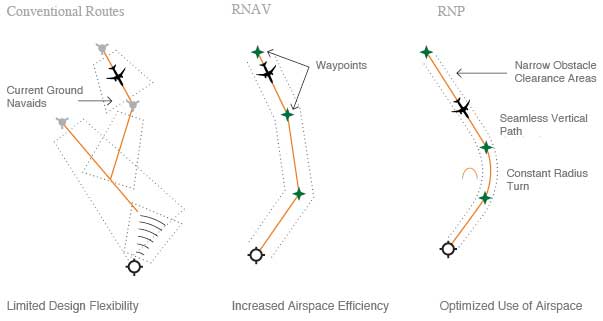
RNAV AND RNP: GOOD CONCEPTS IN NEED OF STREAMLINING
Historically, commercial airplanes have navigated from a position relative to one ground-based navaid — such as very-high-frequency (VHF) omni-directional range (VOR), distance measurement equipment (DME), or non-directional beacon (NDB) — to a position relative to another navaid. Because airplanes are inhibited from flying the most direct possible routes, this method leads to inefficient routes and procedures. Adding to this inefficiency are large airspace separation buffers that commercial airplanes must use because of both the inherent inaccuracies of conventional navigation methods and the need to protect against operational errors.
RNAV began as a means of navigation on a flight path from any point, or fix, to another. These fixes could be defined by a latitude and longitude, and an airplane’s position relative to them could be established using a variety of navaids. RNAV facilitated a type of flight operation and navigation in which the flight path no longer had to be tied directly to overflight of ground navigation stations.
Figure 1

|
RNP is built on RNAV. The International Civil Aviation Organization (ICAO) recognized that global navigation satellite systems, the navigation infrastructure, airline operations, and airplane systems were undergoing change faster than traditional processes for equipment, including RNAV, could support. RNP was developed to allow airspace designers to specify airspace and operation requirements without relying on specific equipment or systems. The original RNP concept was oriented toward enroute, remote, and oceanic airspace, and was primarily concerned with precise navigation and safe separation of routes. Both RNAV and RNP offer a number of advantages over conventional, ground-based navigation systems, including greater safety and efficiency (see fig. 1).
However, as RNP has evolved, some of its elements have been implemented inconsistently. Additionally, RNP applications lacked a common basis for interoperability, creating confusion and hampering adoption. At the same time, work had begun both within and outside ICAO to develop guidance for other phases of flight and operational environments. This work led to the understanding that it would be impossible to achieve global interoperability with these new concepts unless the assumptions on which they are based, such as RNP, were consistently applied. PBN is seen as the solution that will enable future efficiency-enhancing operations concepts.

